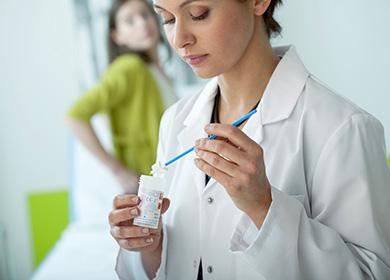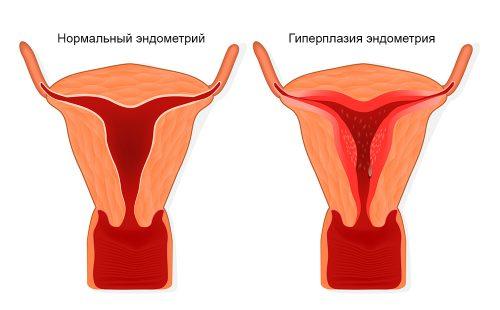The content of the article
Endometry, what is an accessible language and how to treat? The endometrium lines the inner surface of the uterus. This layer is capable of monthly renewal under the influence of female sex hormones: its rejection and restoration is a monthly menstrual cycle. The ability of a woman to conceive and bear a child largely depends on the condition of the endometrium.
There are diseases that destroy the harmonious state of the internal mucous layer of the uterus. The most common are endometritis and endometrial hyperplasia. Sometimes they accompany each other and have similar symptoms. It is very important to differentiate them correctly - this is the only way to choose an effective treatment.
Endometritis: symptoms ...
What does endometritis mean? This is an inflammatory disease of the uterine mucosa. A predisposing factor may be traumatic endometrial damage after childbirth, abortion, and diagnostic procedures. There is a risk in the presence of an intrauterine device. But the main cause of acute inflammation of the uterine mucosa is an infection. An infectious agent may be specific:
The rest of the flora is non-specific. The prevalence of inflammation depends on the degree of involvement of the endometrium: a focus or damage to the entire mucous membrane. During the process, two forms are distinguished: acute and chronic endometritis.
Acute
The disease begins abruptly, the temperature rises. A woman may be disturbed by pain in the lower abdomen, giving in the sacrum and groin, copious discharge with a fetid odor. With a gynecological examination, sharp pain in the uterus and on the sides of it is noted. The echoes of acute endometritis are as follows:
- large uterus;
- the boundaries between the mucous and muscle layers are erased;
- inside the uterus contents with reduced echogenicity;
- fine suspension (pus) can be determined.
When the uterine muscle layer is involved in the process, signs of metroendometritis appear: alternation of areas of increased and decreased echo density in the myometrium.
Chronic
Chronic endometritis often occurs as a result of untreated acute inflammation of the uterine mucosa. For sluggish endometritis, certain morphological signs are typical:
- inflammatory infiltrates;
- sclerotic transformation of blood vessels;
- atrophy or, conversely, mucosal hyperplasia;
- adhesions in the uterine cavity - synechia.
The following symptoms of the disease are determined.
- Menstrual irregularities. The altered endometrium becomes less sensitive to the action of female sex hormones. Menstruation can be irregular, painful, long and plentiful, or, conversely, scarce. Intermenstrual bleeding is often a concern.
- Pathological discharge. A woman may be disturbed by discharge with an unpleasant odor of different consistency.
- Dyspareunia. Normal sex life is disturbed by pain during sexual intercourse. Examination of a gynecologist also causes pain.
- Infertility and miscarriage. In itself, fertilization in chronic endometritis is possible, but the processes of implantation and development of the embryo in the early stages are often disrupted, so in these women there is a history of infertility or habitual miscarriages.
Echoes of chronic endometritis are visible on ultrasound in the form of intrauterine adhesions. Often the thickness of the endometrium does not correspond to the day of the menstrual cycle.
... enlarged and thick endometrium, treatment methods with photos
How is XP endometritis treated? The use of treatment methods depends on the form of the disease. In the acute stage of the disease are shown:
- hospitalization in the gynecology department - bed rest;
- non-drug treatment - cold to the lower abdomen;
- antibiotics - depending on the sensitivity of microorganisms;
- antispasmodics - to improve the outflow of discharge from the uterus;
- infusion therapy - with severe intoxication;
- uterine drainage - with washing with antiseptic solutions.
In chronic endometritis, complex treatment is performed. Hospitalization is not required. An exception is the surgical removal of synechiae. Treatment includes the following steps:
- physiotherapy - improve blood flow in the pelvis;
- spa treatment - healing mud, rhodon baths;
- vitamin therapy - complexes for the general strengthening of the body;
- "Distreptaza" - candles to get rid of adhesions in the pelvis;
- uterine injection of drugs - hyaluronidase, Novocaine, antibiotics;
- hormonal correction - taking oral contraceptives;
- surgery - in the presence of synechia in the uterus.
Endometrial hyperplastic processes: causes and solutions
Endometrial hyperplasia is a process in which pathological proliferation of the uterine mucosa occurs. Main groups of causes are identified.
- Hormonal disorders. Increased estrogen levels with decreased progesterone activity. This can lead to a violation of ovulation, hormone-producing ovarian tumors, impaired pituitary function, pathology of the adrenal cortex, uncontrolled use of hormonal drugs.
- Exchange-endocrine disorders. The pathology of fat metabolism, diseases of the gastrointestinal tract, dysfunctions of the thyroid gland lead to impaired metabolism of sex hormones. Obesity, arterial hypertension, and diabetes mellitus are often combined with hyperplastic processes in the endometrium.
- Chronic inflammation. It leads to damage to receptors located in the thickness of the mucous layer. Endometrial receptors cease to perceive hormonal impulses and give an adequate response.In 95% of patients with a glandular-fibrous polyp, the endometrium is infected or there are signs of its chronic inflammation.
Focal (endometrial polyp) and diffuse endometrial hyperplasia are distinguished depending on the prevalence of the process.
How to suspect a pathology
The main symptoms of endometrial hyperplasia are uterine bleeding, mostly irregular and not coinciding with the menstrual cycle. Often women of reproductive age deal with infertility problems. Endometrial hyperplasia in menopause may not manifest itself in any way and be an accidental find during ultrasound examination.
Diagnostic Standards
A screening examination that allows you to reach the target group en masse is a transvaginal ultrasound study. In women of reproductive age, it is worth evaluating the correspondence of the thickness of the endometrium and the phase of the menstrual cycle. On the stage menopause the thickness of the mucous layer normally should not be more than 4-5 mm.
However, only a thickening of the endometrium can be diagnosed echographically, but it is not possible to differentiate glandular hyperplasia from atypical. Therefore, a reliable diagnosis is possible only after a histological analysis of the affected endometrium. To do this, perform diagnostic curettage or hysteroscopy with a biopsy.
Therapeutic techniques
Therapy of endometrial hyperplasia includes the following main tasks:
- stop the bleeding;
- restore menstrual function in childbearing age;
- to achieve atrophy of the endometrium in menopause;
- prevention of relapse of hyperplasia.
Traditionally, after histological examination of the endometrium, hormone therapy is prescribed. Its purpose is to normalize the regulation of the thickness of the uterine mucosa. It is necessary to take into account the possible infectious component of the disease, therefore antibacterial therapy is sometimes used.
If the disease recurs, then a woman who has already given birth to a sufficient number of children and does not plan a pregnancy in the future may be offered endometrial resection.
With reliably defined atypical hyperplasia, menopausal women are shown to remove the uterus. If the operation is impossible due to severe somatic pathology, the treatment consists in the prolonged use of gestagens.
Folk remedies in the fight against endometrial diseases
It should be noted right away that folk remedies under no circumstances can replace the traditional treatment of pathology of the uterine mucosa. At home, without consulting a doctor, any attempt at therapy is deadly. However, traditional medicine recipes can help in rehabilitation after an illness, as well as in the prevention of relapse.
- Nettle broth. To combat bleeding. Brew one tablespoon of nettle leaves into a glass of boiling water, filter. Drink one tablespoon three times a day.
- Solution eleutherococcus. 2 ml per quarter cup of water, drink three times a day.
- Infusion of currants, rose hips anddaisies. Three tablespoons of wild rose and black currant in combination with one and a half tablespoons of chamomile flowers for half a liter of boiling water. Drink half a glass six times a day.
- Rosehip, St. John's wort andcalendula. We need three teaspoons of wild rose, one tablespoon of hypericum and calendula and a teaspoon of chamomile. Pour 1.5 liters of boiling water.The mixture is left to stand for two hours, filtered and drunk 100 ml six times a day.
The combination of traditional methods of therapy and traditional medicine methods give good results in maintaining the health of the uterine mucosa. However, treatment of endometrial hyperplasia and all types of endometritis is impossible without a radical review of the style and lifestyle. It is necessary to normalize the weight, exclude the possibility of secondary infection, and adjust the hormonal function of the body.


